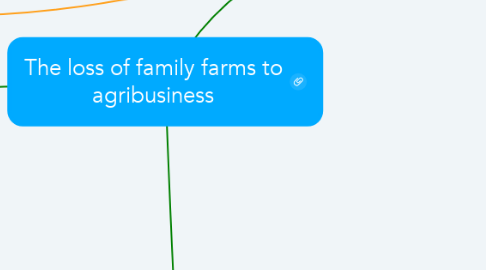
1. Growth of Commercial Agriculture
1.1. Developed countries
1.1.1. Advances in transportation technology meant food could be transported large distances
1.1.1.1. Large centralized farms rather than smaller local producers
1.1.1.1.1. Only 5% of population engaged in farming
1.2. Colonialism by powerful countries (Ex: UK)
1.2.1. Mass production of crops like sugarcane, cotton
1.3. Invention of machinery (Ex: Plows)
1.3.1. Increased production
1.3.1.1. Increased global trade
1.3.1.1.1. Produce food to export
1.4. Implementation of modern technology
1.4.1. 1. During the 18th century, machinery such as the iron plow were being invented. Over the next two centuries, successful farms were able to reinvest profit into these technologies and transition away from animal and manual labor. Subsistence, or family, farms were content with cheaper capital and less production.
1.4.2. 2. Animals such as the horse were being utilized, and inventive farmers wanted to get the full use out of them, invented the plow
1.4.3. 3. Around 8000 BC, was the formation of the 5 crop hearths, (Southwest Asia, East Asia, sub-saharan Africa, Mexico, and Peru) and this allowed for the domestication of the horse in central Asia as well as cattle, sheep, goats, and pigs in Southwest Asia
1.4.3.1. Ex. Beans, cotton, and corn from Mexico and Peru diffused through the Western Hemisphere
1.4.3.1.1. the fusion of crops and animals domestication in agriculture created the foundation for modern agriculture
1.4.3.2. Ex. Barley, lentils, and wheat from southwest Asia diffused west to Europe and east to central Asia
1.4.4. 4. Over hundreds of years, the hunter-gatherers decided to transition to a sedentary lifestyle
1.4.4.1. The major cultural factors behind this transition were the natural human preference for sedentarism, and the gradual collection of agricultural knowledge through language amassed over generations.
1.4.4.2. The end of the last ice age meant higher average temperatures, and an overall climate better suited to agriculture was the major environmental factor behind this.
1.4.5. 5. Around 10000 BC, hunter-gatherers were nomadic, and food supplies were always tenuous. A poor hunting season could mean an entire tribe being wiped out.
2. Agricultural Revolutions
2.1. New machinery
2.1.1. Plows, seed drill, McCormick reaper
2.1.1.1. Agricultural productivity soared
2.1.1.2. Less people needed to work on farms
2.1.1.3. People can move to jobs other than agriculture
2.1.1.3.1. Lee Migration Model - push factor is less job opportunity in farms, pull factor is to the city, potential high wages and abundant job opportunity
2.2. Improved Livestock Breeding
2.2.1. Crop and Livestock farming most common form of agriculture in US west of Appalachians
2.2.1.1. Crops fed to animals = animals provide manure and products
2.2.2. Ranching
2.2.2.1. Growth in ranching has been in developing countries
2.2.2.1.1. China leading producer of meat, followed by United States and Brazil
2.2.2.1.2. Developed countries were responsible for only 1/3 of world meat production in 2013 compared to 2/3 in 1980
2.2.2.2. Commercial grazing of livestock over an extensive area
2.2.2.2.1. Occurs in areas like Australia, Spain, Portugal
2.2.3. Dairy Farming
2.2.3.1. Eastern US - milk sold to consumers (ex. Pennsylvania only 5% processed into other dairy products)
2.2.3.2. Further West - milk processed into cheese, butter, etc. (ex. Wisconsin most milk processed into cheese, butter, etc.)
2.2.3.3. New Zealand - the world's largest per capita producer of dairy products
2.2.3.3.1. too far from North America and west Europe so don't sell too much liquid milk
2.2.3.4. Von Thunen Agricultural Model
2.2.3.4.1. The land closest to the markets it expensive, dairy is very perishable
2.3. Genetically Modified Organisms (GMOs)
2.3.1. Greatly increased agricultural production and efficiency
2.3.1.1. Saved countries like India and China from experiencing mass famine during the 20th century
2.3.2. Larger companies control the seed market as more and more people begin to rely on GMOs
2.3.2.1. Smaller farms are driven out of business
2.3.2.2. Ex. Monsanto, DuPont, Syngenta, and Dow AgroSciences own 80% of corn market and 70% of soybean market
3. Downfall of Small Farms
3.1. Certain regions become more important for commercial agriculture
3.1.1. Ex: Iowa lost 1/3 of its farms; replaced with large commercial farms
3.1.2. Agricultural products are not sold directly to consumers, but rather to food processing companies
3.1.2.1. Large processors sign contracts with commercial farmers to buy their crops and animals
3.1.2.1.1. Ex. General Mills and Kraft
3.1.3. 20% of US Workforce work in food production and services related to agribusiness (packaging, storage, etc.)
3.1.4. 6 Main Types of Commercial Agriculture
3.1.4.1. Grain Farming (China, India, United States)
3.1.4.2. Mediterranean Agriculture (Southern Europe, North Africa, western Asia, California, etc.)
3.1.4.3. Gardening and Fruit Farming (southeastern United States, New England, etc.)
3.1.4.4. Mixed Crop and Livestock (Ohio to Dakotas, centered around Iowa - called Corn Belt sometimes)
3.1.4.5. Dairy
3.1.4.6. Ranching
3.2. Developing countries
3.2.1. Large population and low infrastructure
3.2.1.1. Subsistence farming
3.2.1.1.1. 44% of population of developed countries engaged in farming
3.2.1.1.2. Increase production in two main ways
3.3. Farms become owned by large corporations
3.3.1. The top 10 percent of farms in terms of size in the U.S. own 70% of cropland
3.3.1.1. Ex: Farm bankruptcies up 50 percent in the Northwest
